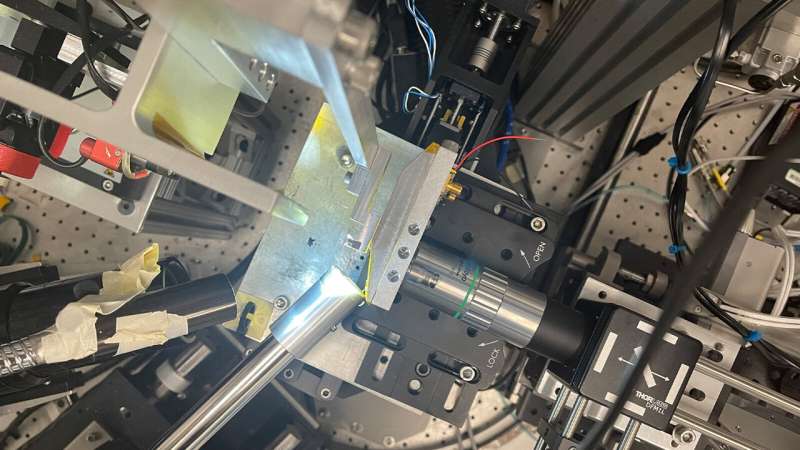
Using the bright X-rays of the Advanced Photon Source and a custom-built characterization platform, scientists have traced the ion movements inside perovskites, a potential material for new solar energy harvesting devices.
Solar farms are gaining an increasing foothold in combating climate change, and scientists are on the hunt for new materials to make solar panels even more efficient. Increasing that efficiency means studying light-detecting and light-emitting materials, which form the basis of the study of optoelectronics. One class of these new materials is called perovskites.
Researchers using the Advanced Photon Source (APS), a U.S. Department of Energy (DOE) Office of Science user facility at DOE's Argonne National Laboratory, recently published a study in Joule revealing the way ions move within different perovskite crystals under ultraviolet radiation (UV). Scientists are interested in testing material stability under UV because it can significantly degrade solar cell performance, sometimes by more than 50%, after extended exposure.
Electricity is harvested from light when it collides with a solar cell, knocking electrons out of their bonds and allowing them to circulate and move around. However, instability in perovskites means that iodine, for example, leaves the system as iodine gas, creating a vacancy for ions to migrate towards, causing defects that make the system cease functioning. Researchers hope to improve perovskite stability to achieve a solar cell lifetime of twenty to thirty years, making them more useful to industry.
"Perovskite has a lot of potential for solar cells, and also for use in LED displays. At Argonne, we hope to use the powerful X-ray beams to decode perovskites' mysteries and uncover potential pathways to conquer their stability hurdles," said Argonne materials scientist Yanqi (Grace) Luo, the lead author on the paper.
Perovskites' potential use in solar cells is high on the list for the next solar energy breakthrough in climate resilience. Commercial multicrystalline silicon solar cells can convert 10–15% of the sun's energy to electricity. But perovskites, since initial experiments in 2009, have increased that to as much as 26%, outperforming many other types of solar cells.
To enhance perovskite solar energy conversion, scientists improve material stability through innovative compositions and structural engineering. By altering halide ratios and adding these ions in varying sizes or amounts, scientists can change favorably perovskites' nature and use.
Since the light-harvesting characteristics of these hybrid perovskites are unstable and easily altered, extra care and a specially designed scientific setup were required to study them. Some microscopes can record only a snapshot, providing a certain set of information about a sample at the instant of measurement. Instruments at the APS can record and provide data on conditions of the sample during the entire observation, meaning researchers studying nanoscience can witness changes as they occur.
Luo's team has shown that by using a sophisticated technique called nanoprobe X-ray fluorescence (nano-XRF), they can directly capture the movement of halide atoms in perovskite materials before damaging them.
More information: Yanqi Luo et al, Photo-induced halide redistribution in 2D halide perovskite lateral heterostructures, Joule (2023). DOI: 10.1016/j.joule.2023.08.003
Journal information: Joule
Citation: X-rays light the way to more stable solar cell materials (2024, January 23) retrieved 23 January 2024 from https://techxplore.com/news/2024-01-rays-stable-solar-cell-materials.html
This document is subject to copyright. Apart from any fair dealing for the purpose of private study or research, no part may be reproduced without the written permission. The content is provided for information purposes only.
